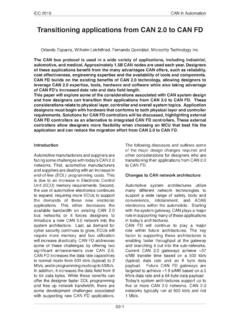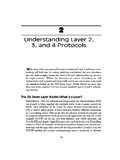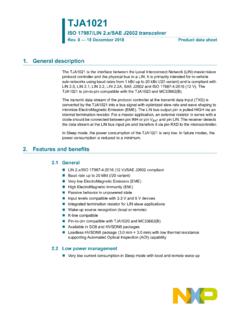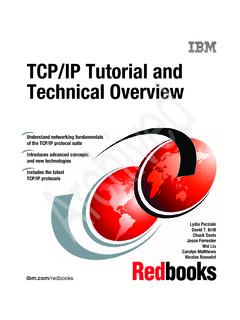Transcription of System Management Bus
1 System Management Bus (SMBus) Specification Version SBS Implementers Forum 1 System Management Bus (SMBus) Specification Version August 3, 2000 SBS Implementers Forum Copyright 1994, 1995, 1998, 2000 Duracell, Inc., Energizer Power Systems, Inc., Fujitsu, Ltd., Intel Corporation, Linear Technology Inc., Maxim Integrated Products, Mitsubishi Electric Semiconductor Company, PowerSmart, Inc., Toshiba Battery Co. Ltd., Unitrode Corporation, USAR Systems, Inc. All rights reserved. System Management Bus (SMBus) Specification Version SBS Implementers Forum 2 THIS SPECIFICATION IS PROVIDED AS IS WITH NO WARRANTIES WHATSOEVER, WHETHER EXPRESS, IMPLIED OR STATUTORY, INCLUDING BUT NOT LIMITED TO ANY WARRANTY OF MERCHANTABILITY, NONINFRINGEMENT OR FITNESS FOR ANY PARTICULAR PURPOSE, OR ANY WARRANTY OTHERWISE ARISING OUT OF ANY PROPOSAL, SPECIFICATION OR SAMPLE.
2 IN NO EVENT WILL ANY SPECIFICATION CO-OWNER BE LIABLE TO ANY OTHER PARTY FOR ANY LOSS OF PROFITS, LOSS OF USE, INCIDENTAL, CONSEQUENTIAL, INDIRECT OR SPECIAL DAMAGES ARISING OUT OF THIS SPECIFICATION, WHETHER OR NOT SUCH PARTY HAD ADVANCE NOTICE OF THE POSSIBILITY OF SUCH DAMAGES. FURTHER, NO WARRANTY OR REPRESENTATION IS MADE OR IMPLIED RELATIVE TO FREEDOM FROM INFRINGEMENT OF ANY THIRD PARTY PATENTS WHEN PRACTICING THE SPECIFICATION. * Other product and corporate names may be trademarks of other companies and are used only for explanation and to the owner s benefit, without intent to infringe. Revision No. Date Notes 2/15/95 General Release 12/11/98 Version Release 8/3/00 Version Release Questions and comments regarding this specification may be forwarded to: For additional information on Smart Battery System Specifications, visit the SBS Implementer s Forum (SBS-IF) at: System Management Bus (SMBus) Specification Version SBS Implementers Forum 3 Table of Contents 1.
3 Overview .. 5 Audience .. 5 Scope .. 5 Organization of this 5 Supporting documents .. 6 Definitions of 6 Conventions .. 8 2. GENERAL CHARACTERISTICS .. 9 3. LAYER 1 THE PHYSICAL LAYER .. 11 Electrical characteristics of SMBus devices two discrete 11 SMBus common AC specifications .. 11 Low-power DC 14 High-Power DC 16 Additional common low and high-power 17 4. LAYER 2 THE DATA LINK LAYER .. 18 Bit transfers .. 18 Data 18 START and STOP conditions .. 18 Bus idle condition .. 18 Data transfers on SMBus .. 19 Clock generation and arbitration .. 20 Synchronization .. 20 21 Clock low extending .. 22 Data transfer formats .. 23 5. LAYER 3 NETWORK LAYER .. 24 Usage model .. 24 Device identification slave address.
4 24 SMBus address types .. 25 Using a device .. 26 System Management Bus (SMBus) Specification Version SBS Implementers Forum 4 Packet error checking .. 26 Packet error checking implementation .. 26 Bus Protocols .. 27 Quick command .. 28 Send 29 Receive 29 Write byte/word .. 29 Read byte/word .. 30 Process call .. 31 Block write/read .. 31 Block write-block read process call .. 32 SMBus host notify protocol ..34 SMBus Address resolution protocol ..34 Unique Device Identifier (UDID) .. 34 Power-on reset .. 38 ARP commands .. 38 APPENDIX A OPTIONAL SMBUS SIGNALS .. 54 SMBSUS# .. 54 SMBALERT# .. 55 APPENDIX B DIFFERENCES BETWEEN SMBUS AND I2C .. 57 DC specifications for SMBus and 57 Timing specification differences between SMBus and I2C.
5 58 Other 58 APPENDIX C SMBUS DEVICE ADDRESS ASSIGNMENTS .. 59 System Management Bus (SMBus) Specification Version SBS Implementers Forum 5 1. Introduction Overview The System Management Bus (SMBus) is a two-wire interface through which various System component chips can communicate with each other and with the rest of the System . It is based on the principles of operation of I2C*. SMBus provides a control bus for System and power Management related tasks. A System may use SMBus to pass messages to and from devices instead of tripping individual control lines. Removing the individual control lines reduces pin count. Accepting messages ensures future expandability. With System Management Bus, a device can provide manufacturer information, tell the System what its model /part number is, save its state for a suspend event, report different types of errors, accept control parameters, and return its status.
6 Audience The target audience for this document includes but is not limited to: System designers implementing the System Management Bus Specification in their systems VLSI engineers designing chips to connect to the System Management Bus Software engineers writing support code for System Management Bus chips Scope This document describes the electrical characteristics, network control conventions and communications protocols used by SMBus devices. These can be thought as existing at the first three layers of the seven-layer OSI network model , that is, the physical, data link and network layers. Functions normally implemented at higher layers of the OSI model are beyond the scope of this document. The original purpose of the SMBus was to define the communication link between an intelligent battery, a charger for the battery and a microcontroller that communicates with the rest of the System .
7 However, SMBus can also be used to connect a wide variety of devices including power-related devices, System sensors, inventory EEPROMs communications devices and more. This version of the specification is a superset of previous versions, and All devices compliant with these previous versions are compliant with this version. Those features new to SMBus with this version of the spec are optional and are appropriate to the new environments enabled by those features. However, if implemented, these new features must be implemented in a manner compliant with this specification. Organization of this document This document is organized to first give the reader an overview of the SMBus and then to delve deeper into its actual working. The major technical discussion appears in three sections that treat the various aspects of the SMBus as they would appear in the first three layers of the OSI reference network model , the physical layer the data link layer and the network layer.
8 The section on the physical layer sets out SMBus electrical characteristics. The section on the data link layer specifies bit transfers, byte data transfers, arbitration and clock signals. The section on the link layer deals with the general usage model , the concept of addresses in SMBus, the Address Resolution Protocol and the bus data transfer protocol. All aspects of the SMBus proper may be described within the scope of the first three OSI layers. The SMBus is a multiple attachment bus with no routing capability. Most communication occurs between and involves only two nodes, a master and a slave. Exceptions to this rule occur during and apply to devices that implement the Address Resolution Protocol as well as the Alert Response Address. System Management Bus (SMBus) Specification Version SBS Implementers Forum 6 Appendixes at the end of this document contain additional information and guides to implementation that the reader may find useful.
9 Supporting documents This specification assumes that the reader is familiar with or has access to the following documents: The I C-bus and how to use it, Philips Semiconductors document #98-8080-575-01. ACPI Specification, Version , Intel Corporation, Microsoft Corporation, Toshiba Corp., February 2, 1999 ( ~acpi) PCI Local Bus Specification, revision , December 18, 1998, ( ) SMBus Control Method Interface Specification, Version , Smart Battery System Implementers Forum, December 1999 Definitions of terms The following terms are defined with respect to this specification and may have other meanings in other contexts. Some of these terms are used throughout the specification while others have meaning only within limited portions. They are defined here so that the reader may be able to find their definitions in one place.
10 Address Resolution Protocol A protocol by which SMBus devices with assignable addresses on the bus are enumerated and assigned non-conflicting slave addresses. Address Resolved flag (AR) A flag bit or state internal to a device that indicates whether or not the device s slave address has been resolved by the ARP Master. Address Valid flag (AV) A flag bit or state internal to a device that indicates whether or not the device s slave address is valid. This bit must be non-volatile for devices that support the Persistent Slave Address. ARP Address Resolution Protocol SMBus ARP Enumerator An SMBus master that uses a subset of the ARP for the purpose of discovering ARP-capable slave devices and their assigned slave addresses. ARP Master The SMBus master (hardware, software or a combination) responsible for executing the ARP and assigning addresses to ARP-capable slave devices.












